The Amflow PL Carbon Pro has entered the e-bike arena, not with a whisper, but with a resounding roar, primarily thanks to its groundbreaking DJI Avinox motor. After spending a day rigorously testing this trail e-bike, I can confidently say that the hype surrounding this motor is not just marketing bravado – it’s genuinely game-changing. While the bike itself presents a familiar trail-ready package, the motor elevates the entire riding experience to an unprecedented level, particularly in terms of responsiveness and intuitive power delivery.
Pros
- Unrivaled motor responsiveness, creating an incredibly connected ride feel.
- Well-rounded frame and suspension performance, suitable for diverse trail conditions.
- Immense power output, easily tackling steep inclines and challenging terrain.
Cons
- Long-term reliability and after-sales support remain uncertain for this new entrant.
- Geometry, while competent, could benefit from modern updates for enhanced downhill prowess.
- The headline-grabbing peak power figures are not always fully exploitable on technical trails.
Earlier this year, the e-bike industry seemed to be progressing at a steady pace, until Amflow, powered by DJI, burst onto the scene with technology that feels distinctly ahead of its time. The buzz surrounding the Amflow PL Carbon Pro is undeniably centered on its DJI Avinox motor. This powerhouse has captured headlines and sparked considerable interest among riders seeking the next level of e-MTB performance.
However, the “Amflow” aspect of this equation has been somewhat overshadowed. Understandably so, as the bike itself adopts a deliberately understated and conventional approach. It’s a classic carbon fiber four-bar linkage frame, dressed in black, with geometry figures that sit squarely in the middle of the trail bike spectrum.
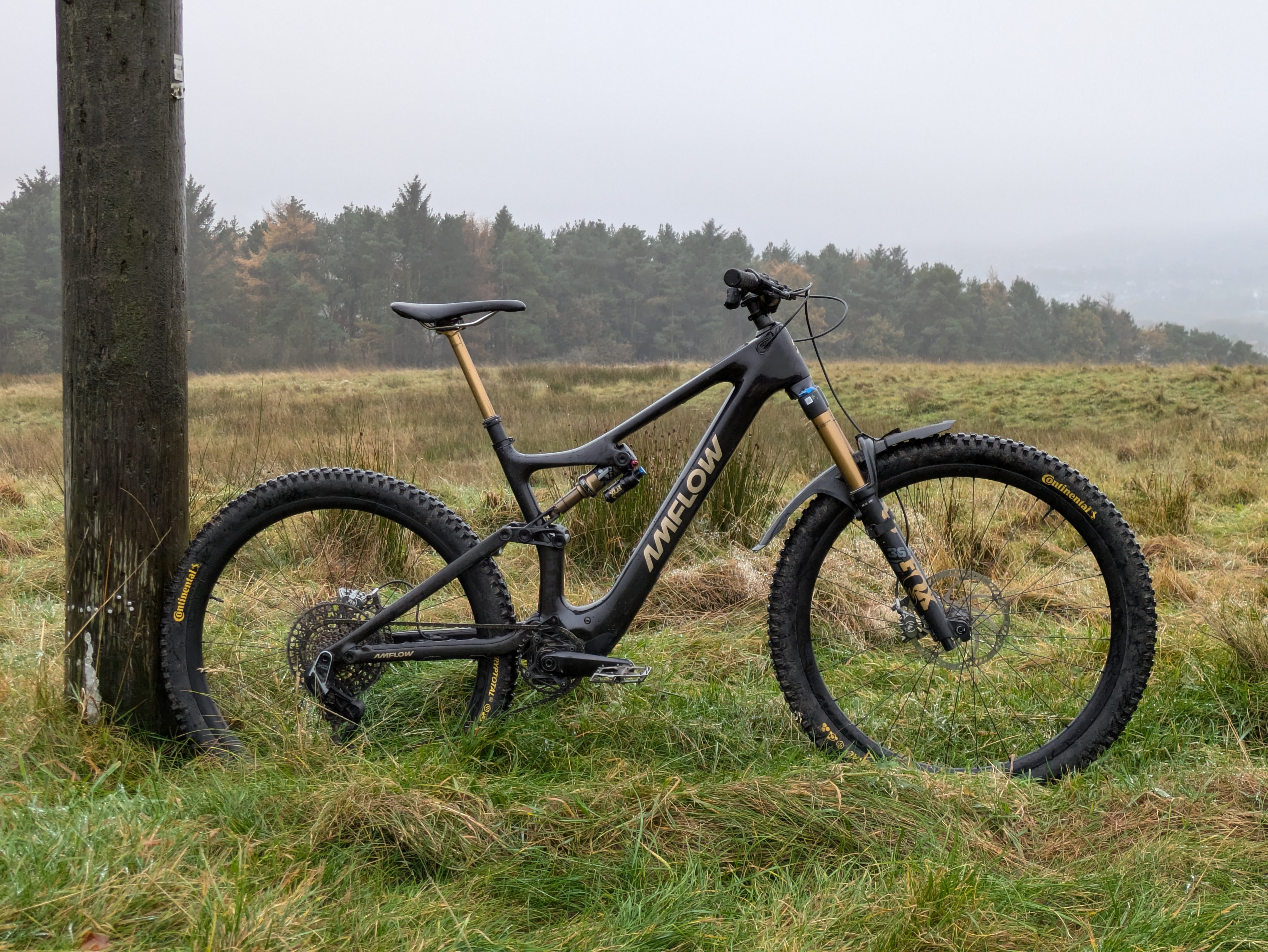 Amflow PL Carbon Pro side profile on trail
Amflow PL Carbon Pro side profile on trail
Unlike some of the more visually striking e-MTBs emerging from brands traditionally outside the cycling world, the Amflow PL Carbon Pro avoids any radical design statements. It’s a departure from the often flamboyant aesthetics seen from motorbike or automotive brands venturing into e-bikes. Amflow instead focuses on delivering performance within a familiar and functional design language.
Positioned firmly within the trail bike category, the Amflow offers 150mm of rear travel paired with a 160mm fork. This isn’t an enduro bruiser nor a dedicated bike park machine. The Amflow PL Carbon Pro is engineered for covering ground efficiently and tackling diverse trails with agility and speed.
But let’s be honest, the real draw here is the motor. While the frame and components are important, the DJI Avinox M1 motor is the star of the show. So, let’s delve into the numbers and the performance that sets this e-bike apart.
Numbers are indeed a compelling starting point. Let’s talk power, battery capacity, and overall bike weight.
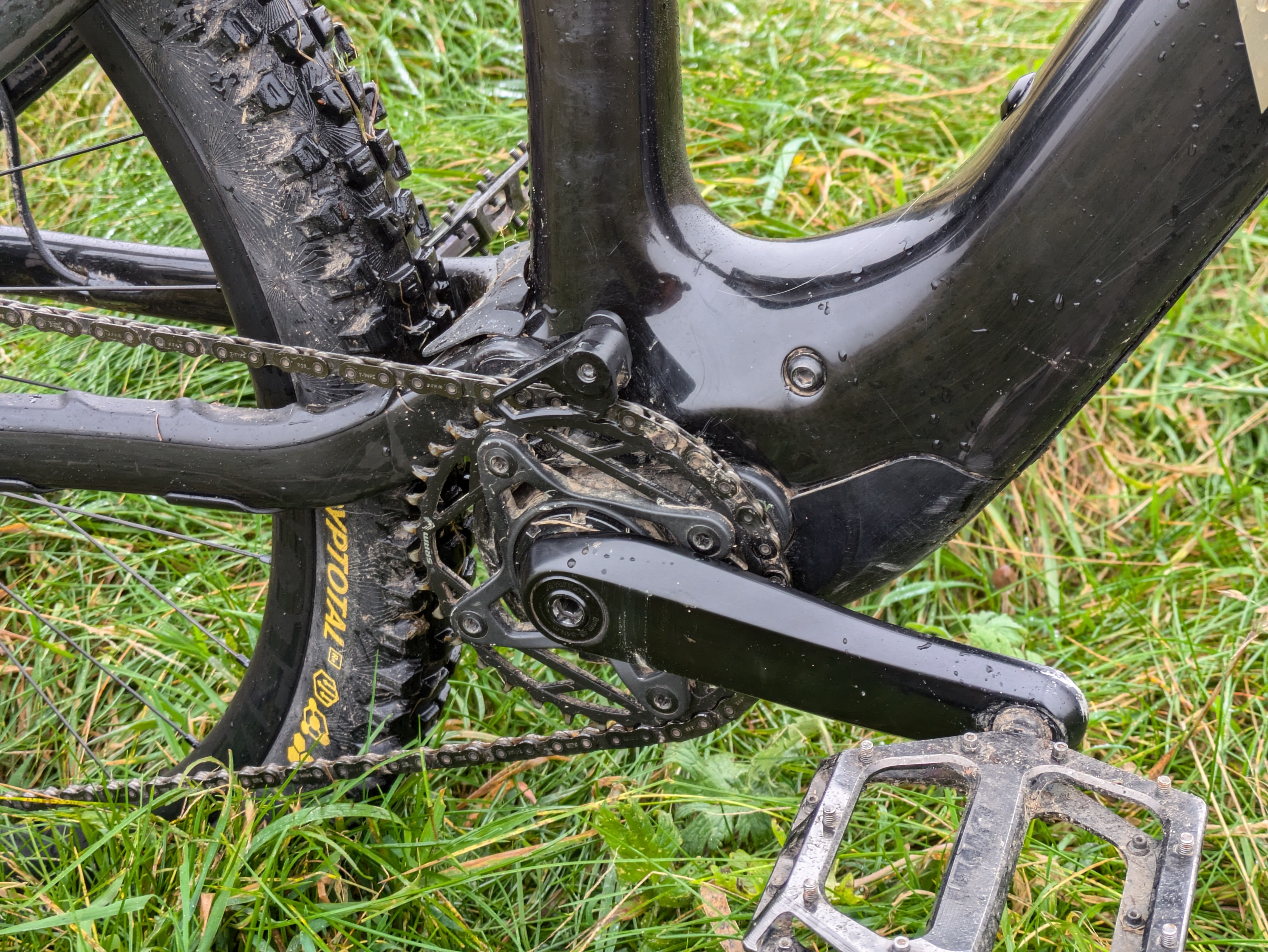 Close-up of DJI Avinox motor on Amflow bike
Close-up of DJI Avinox motor on Amflow bike
The DJI Avinox M1 motor boasts an impressive 105Nm of torque and 850 watts of peak power in its standard assist modes (Eco, Trail, and Turbo). Furthermore, an intelligent “Auto” mode dynamically adjusts assist levels between Eco and Turbo, adapting to rider input and terrain changes.
For moments when you need an extra surge, the “Boost” mode delivers a staggering 120Nm of torque and 1,000 watts of peak power for 30-second bursts. Activated by a simple long-press of the “+” button on the handlebar remote, Boost can be disengaged at any time by pressing any button.
To put these figures into perspective, typical full-power e-MTBs generate around 85Nm of torque and 600 watts of peak power, often with motors that weigh more than the remarkably light 2.5kg DJI Avinox.
Comparing the Amflow to lightweight “mid-power” e-MTBs – those around the 20kg mark, equipped with motors like the TQ HPR-50, Fazua Ride60, Bosch SX, or Specialized SL2 (producing 50-60Nm of torque) – the DJI motor’s power advantage becomes even more pronounced. The Avinox motor simply operates in a different league in terms of raw output.
Battery options for the top-tier Pro model include 600Wh and 800Wh internal batteries. My test bike was equipped with the larger 800Wh battery, weighing 3.74kg and integrated within the frame (requiring motor removal for access). In today’s e-bike market, the trend leans heavily towards maximizing battery capacity, and the 800Wh option is likely to be the popular choice.
While a 600Wh battery (2.87kg) could bring the bike closer to the coveted 20kg weight mark, the extended range of the 800Wh battery offers significant real-world benefits. Currently, Amflow does not offer range extender options, making the choice between battery capacities a crucial consideration for potential owners.
Interestingly, the more affordable Amflow models are exclusively available with the 800Wh battery, making the battery size decision only relevant for those opting for the Pro model.
In terms of overall weight, my Large-size Amflow PL Carbon Pro test bike, equipped with robust Continental Kryptotal Super Soft DH tires, a front mudguard, and DMR Vault flat pedals, tipped the scales at 21.69kg. A 600Wh battery version would shave this down to approximately 20.82kg. This places the Amflow in a competitive weight bracket for a full-power e-MTB, especially considering the substantial battery capacity.
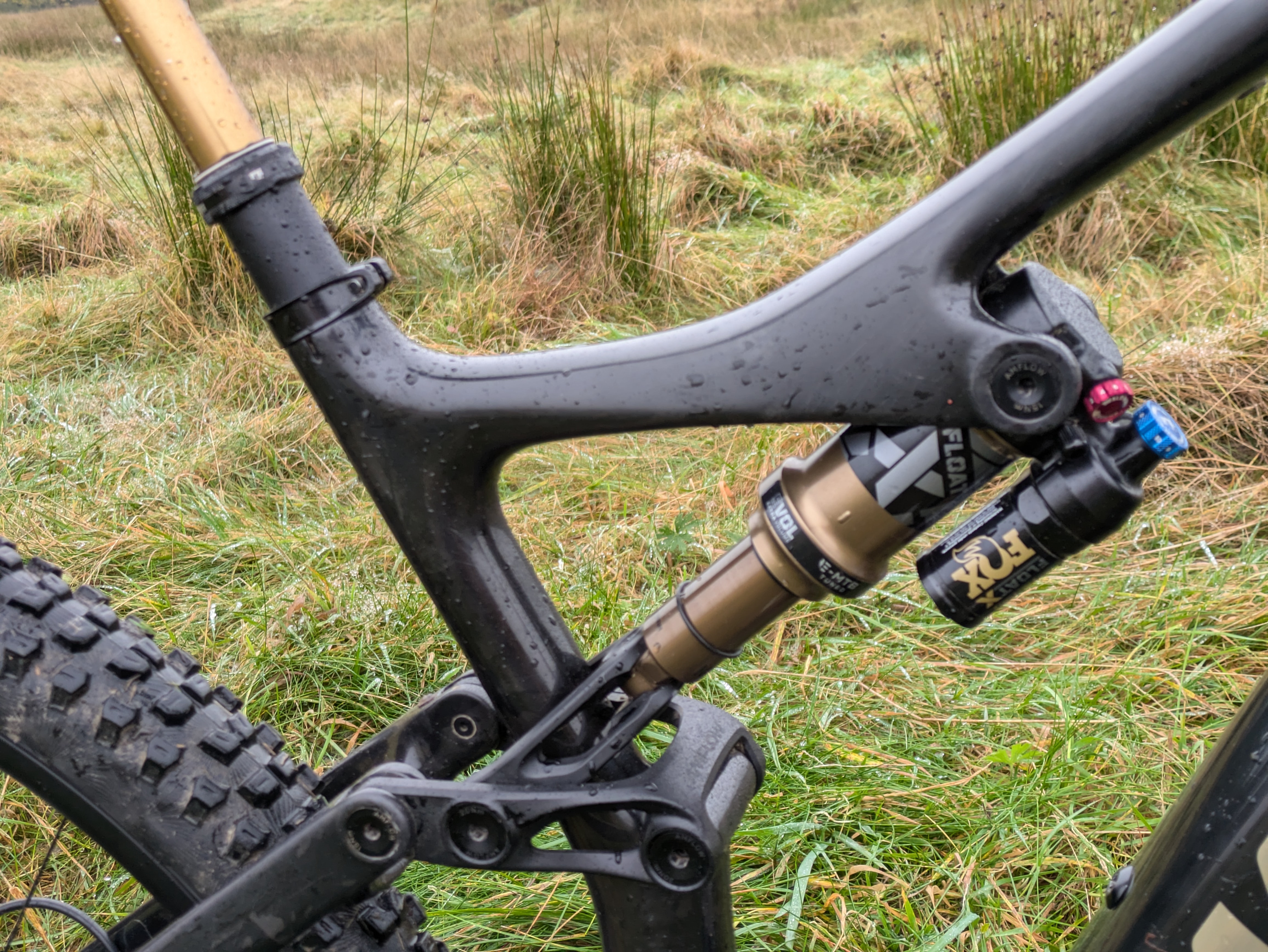 Amflow PL Carbon Pro handlebar controls and display
Amflow PL Carbon Pro handlebar controls and display
The user interface and controls often make or break an e-bike experience. Many brands excel in motor technology but falter in delivering intuitive and user-friendly interfaces. Fortunately, Amflow, powered by DJI, appears to have prioritized this aspect.
While I didn’t test the smartphone app during my day with the Amflow, the on-bike controls and display impressed me. The OLED display integrated into the top tube is clear, informative, and even features touchscreen functionality, although I primarily used the handlebar remotes for navigation. The display’s graphics, with a slightly futuristic aesthetic, might not be to everyone’s taste, but the functionality and clarity are undeniable.
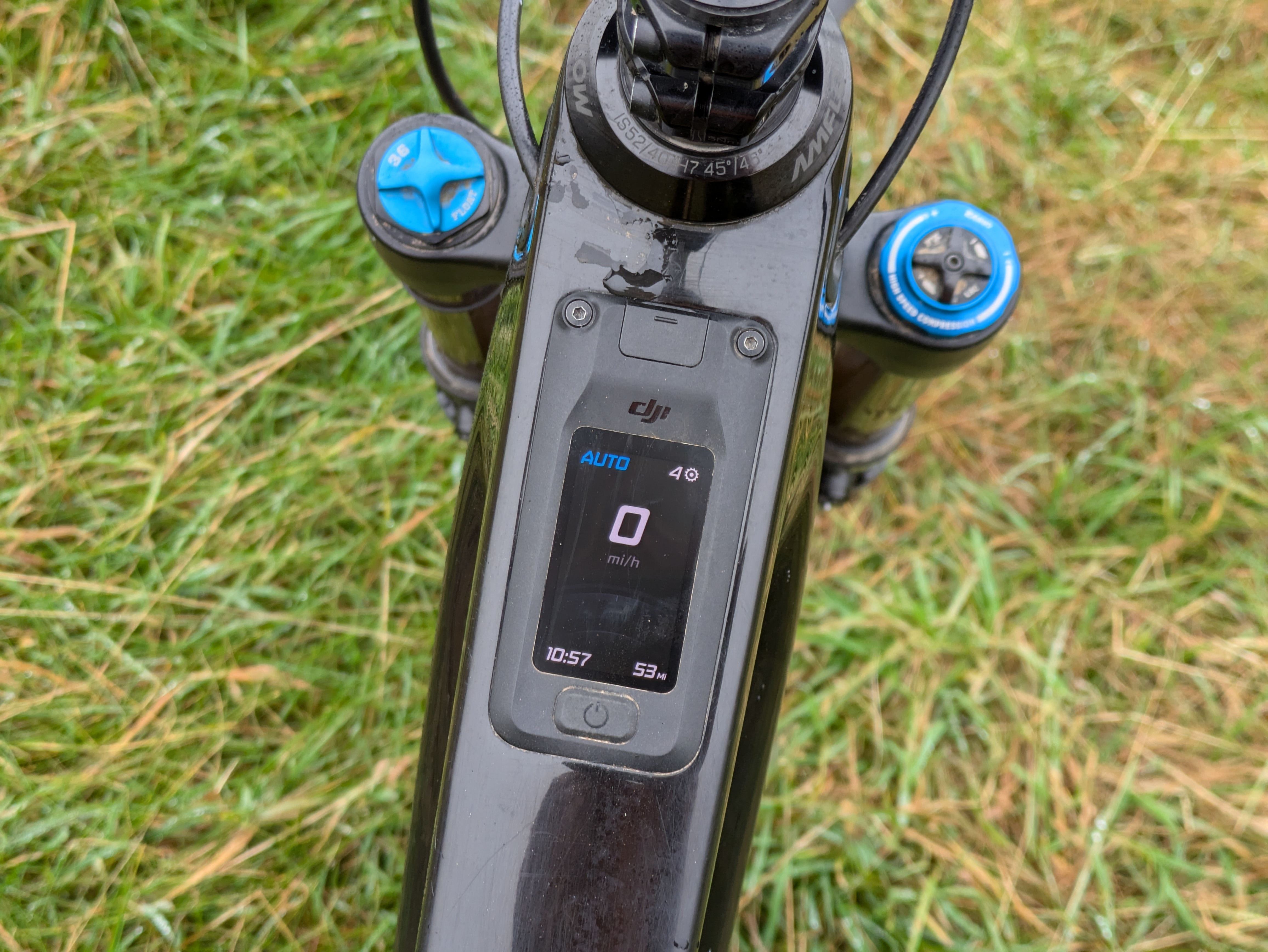 Amflow PL Carbon Pro handlebar remotes close up
Amflow PL Carbon Pro handlebar remotes close up
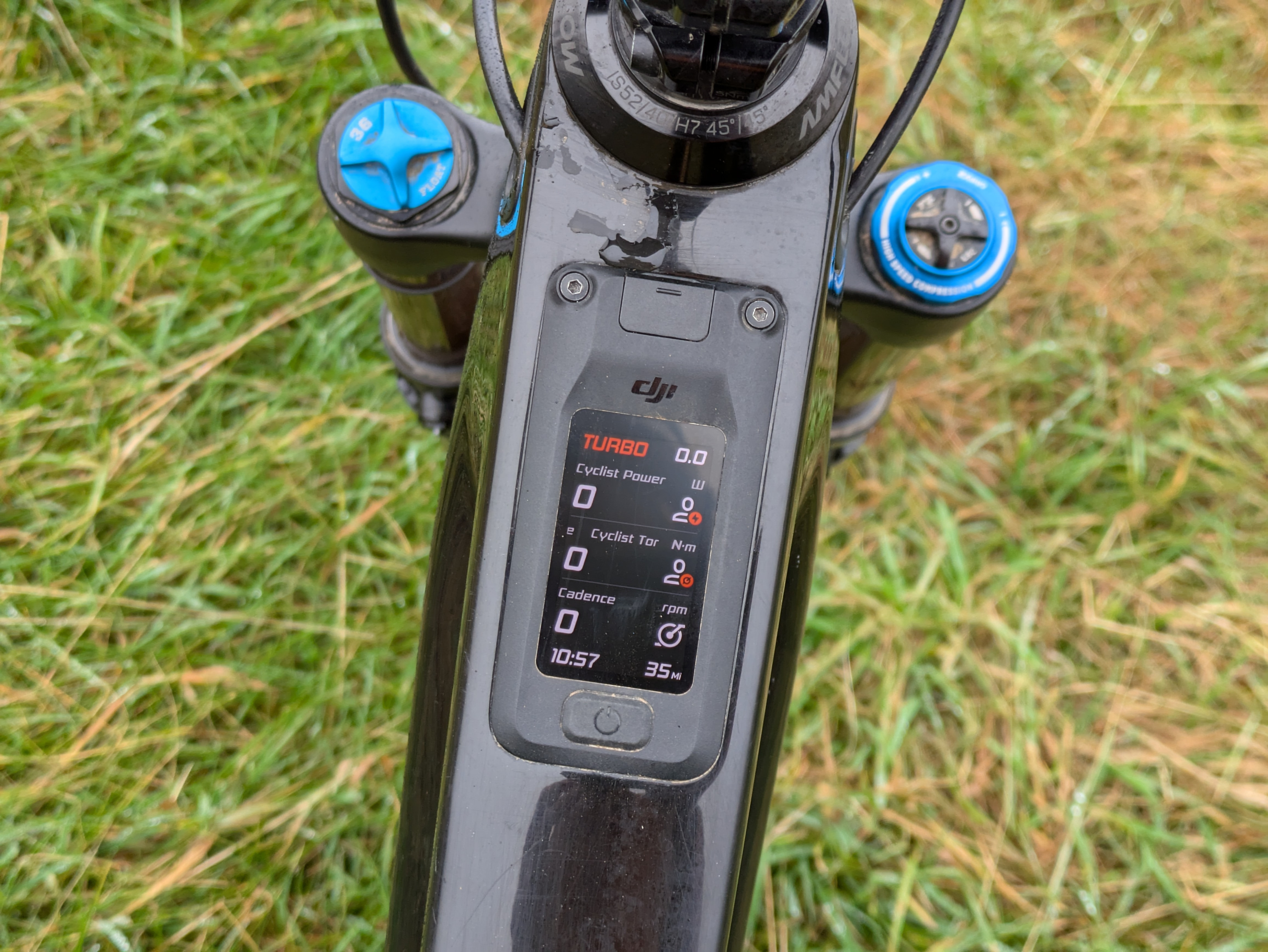 Amflow PL Carbon Pro OLED display integrated into top tube
Amflow PL Carbon Pro OLED display integrated into top tube
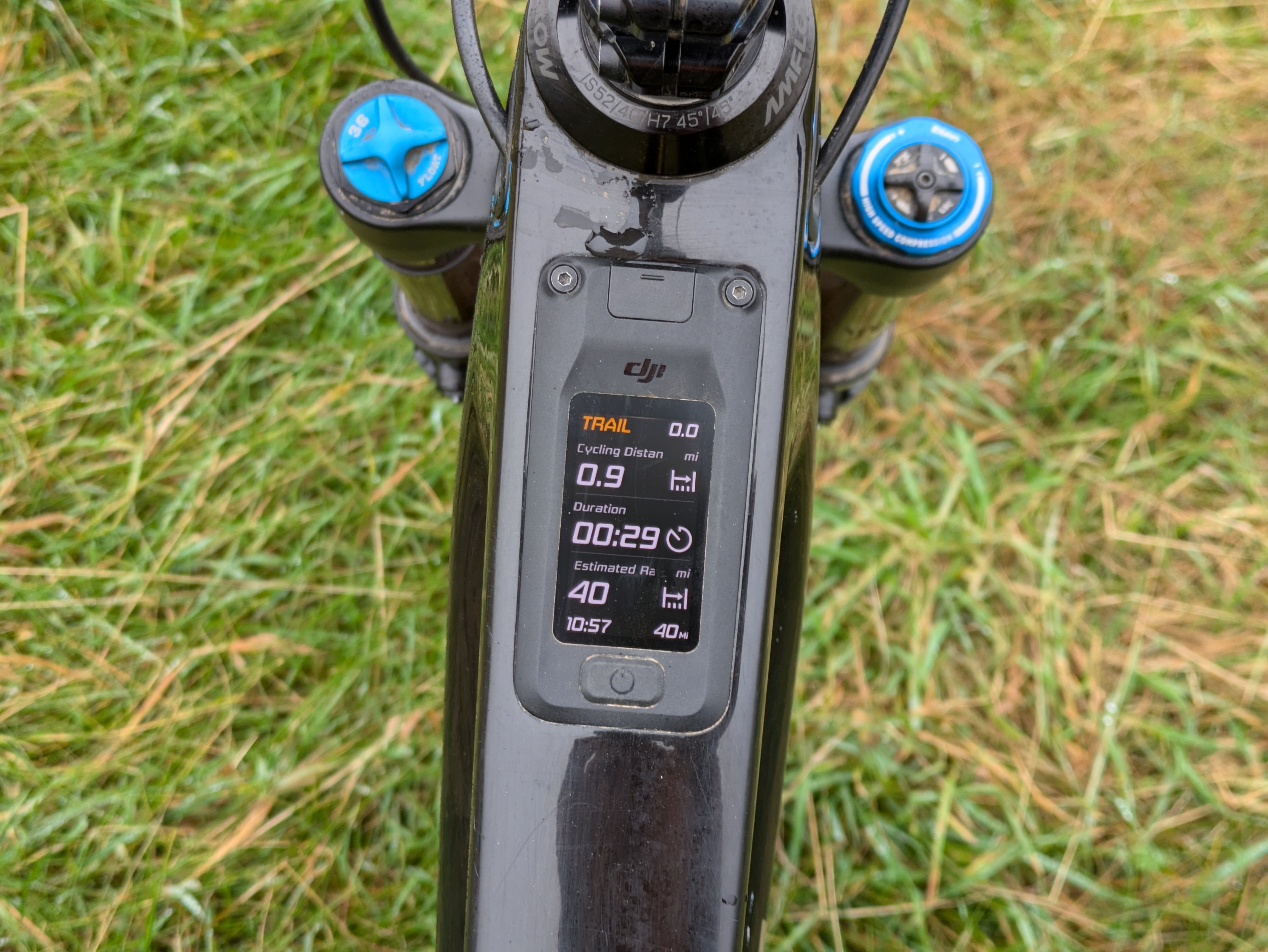 Amflow PL Carbon Pro handlebar control detail
Amflow PL Carbon Pro handlebar control detail
The Amflow employs a dual remote system – one on each side of the handlebar. The left remote handles power assist levels, while the right remote controls display screens and can be customized via the app for functions like controlling a DJI action camera. The remotes are wireless (Bluetooth), and riders can even opt to use just the OLED touchscreen and the physical power button for a minimalist setup.
One standout feature that I found myself using extensively was the “Auto” assist mode. Unlike some other auto modes that can feel sluggish or unpredictable, the DJI Avinox’s Auto mode is remarkably responsive and intuitive. It seamlessly adjusts assist levels to match riding conditions, making it a genuinely useful feature for varied terrain. In fact, I suspect I would leave the bike in Auto mode for the vast majority of my rides.
The polish and refinement of the DJI system on the Amflow suggest this is far from a first attempt. This isn’t a tentative foray into the e-bike market; it’s a product of extensive development. Amflow revealed that the Avinox motor has undergone approximately 11 iterations, and the frame itself has seen seven revisions throughout the development process. This level of dedication to refinement is evident in the final product.
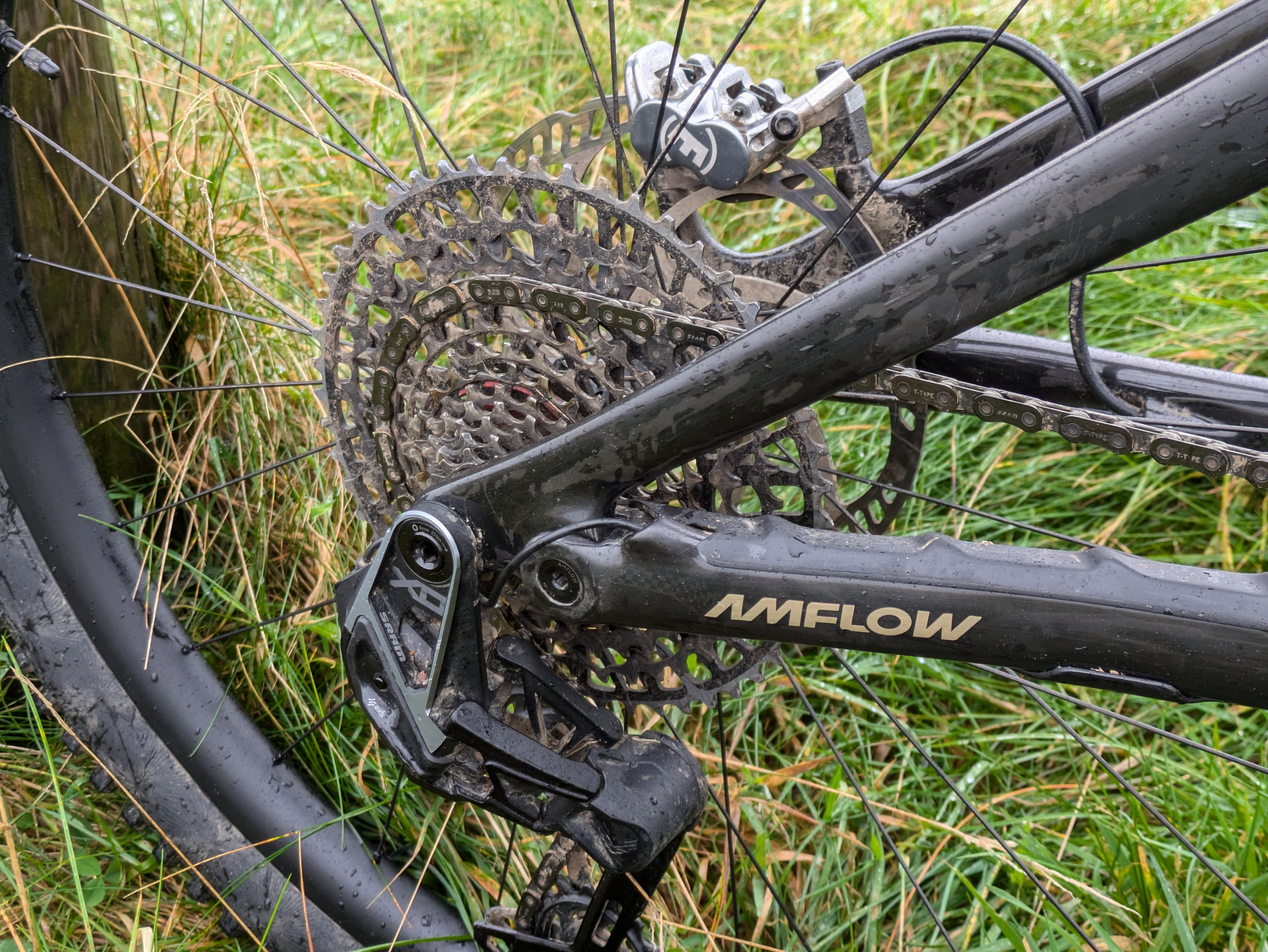 Amflow PL Carbon Pro rear wheel and sensor detail
Amflow PL Carbon Pro rear wheel and sensor detail
While every e-bike motor manufacturer touts their sensor technology, the DJI Avinox motor’s responsiveness truly stands out. It feels like there’s more at play than just standard speed, cadence, and torque sensors. The Avinox motor incorporates inertia sensors for acceleration and a high-resolution rear wheel speed sensor with 42 points of detection (compared to the single sensor common on other e-bikes).
This wealth of sensor data, particularly from the 42-point speed sensor, allows the motor to precisely understand rider input and terrain demands. This sophisticated sensor array is likely the key to the motor’s exceptional responsiveness and intuitive power delivery.
The Avinox motor excels at modulating power output. The power delivery tapers off almost instantly when pedaling input ceases, eliminating the sometimes disconcerting “overrun” effect found in other motors. This immediate response is particularly advantageous on technical climbs and unpredictable trails, offering superior control compared to systems that continue to push after you stop pedaling. For navigating unfamiliar or constantly changing terrain, this responsiveness is a significant advantage.
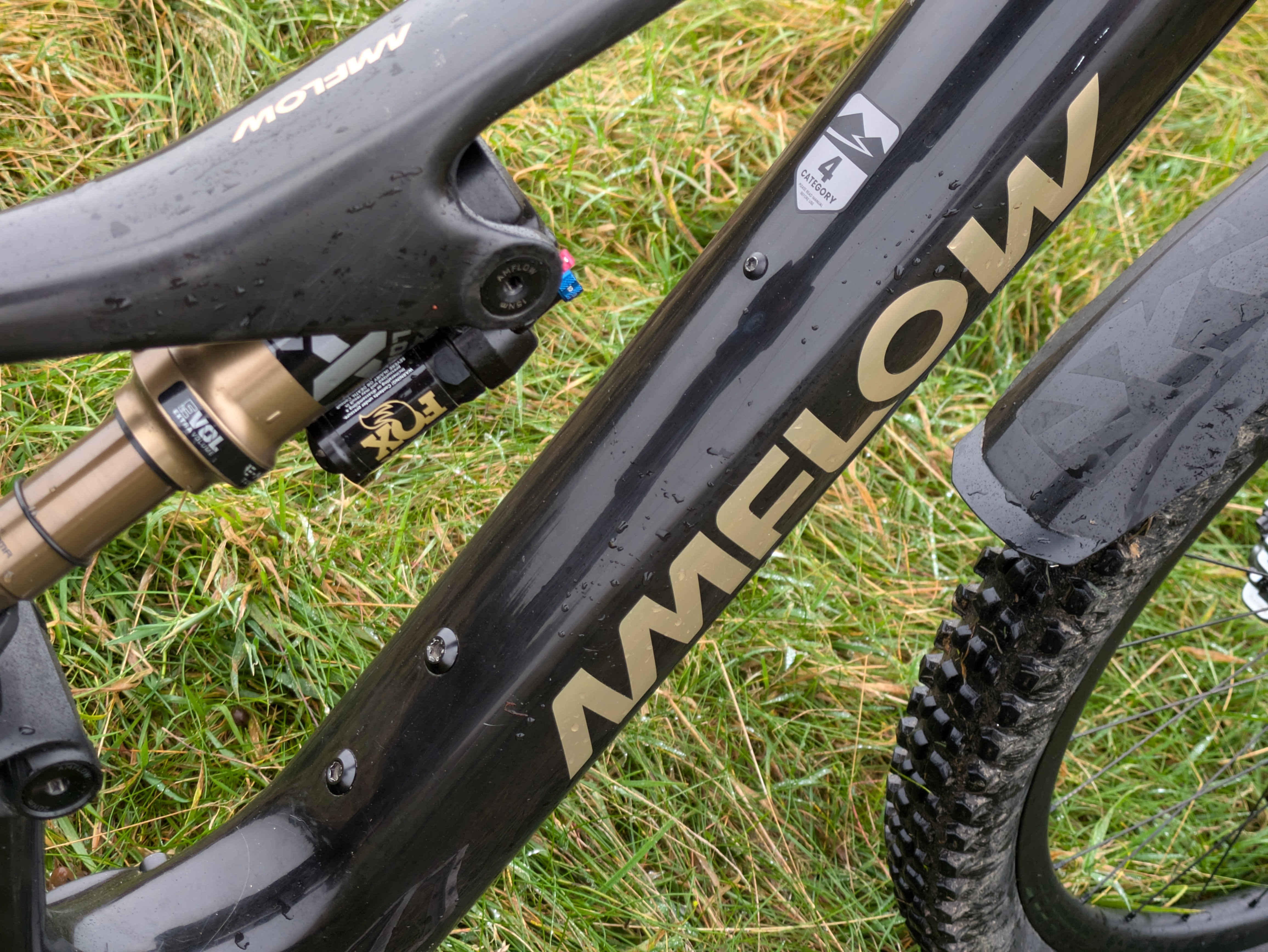 Amflow PL Carbon Pro climbing on a trail
Amflow PL Carbon Pro climbing on a trail
The Amflow PL Carbon Pro, thanks to its exceptional motor, is already among the top climbing e-MTBs available. In fact, the DJI Avinox motor may very well be the best climbing motor currently on the market. However, the frame’s geometry holds it back from being an absolute ascending champion. A steeper seat tube angle and slightly longer chainstays, especially on larger frame sizes, would further optimize climbing performance and balance.
Raw power alone can only take you so far uphill. Eventually, steep gradients will cause the front wheel to lift as weight shifts rearward. The Maxxis Dissector rear tire, while capable, may also reach its traction limit on extreme climbs. E-MTBs with less powerful motors but more optimized climbing geometry can sometimes outperform the Amflow on the steepest, most technical ascents.
The infamous “Boost” mode, while boasting incredible power figures, proved less practical on technical singletrack. It simply delivers too much power too quickly, often overwhelming traction. However, on smoother surfaces like roads and fire roads, Boost mode is exhilaratingly fast. But even here, the 15mph speed limit for e-bikes arrives very rapidly, curtailing the full potential of the Boost.
Boost mode could be beneficial for gravity-focused riders seeking rapid uploads for laps. However, the Amflow’s trail bike configuration isn’t ideally suited for aggressive bike park riding. It lacks the suspension travel and geometry of dedicated gravity bikes. The Amflow remains, at its core, a trail bike.
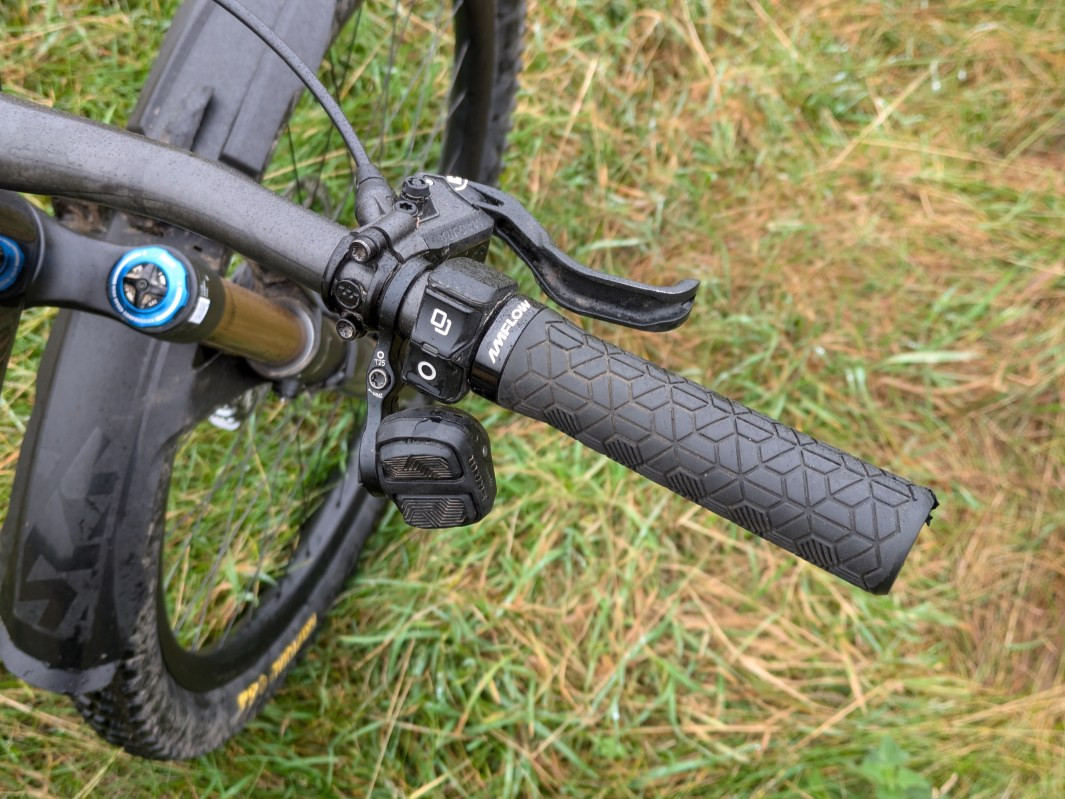 Amflow PL Carbon Pro descending on a trail
Amflow PL Carbon Pro descending on a trail
Suspension performance on the Amflow is generally positive. The Fox 36 fork is a proven performer, and I personally prefer it to the stiffer Fox 38 for my weight (73kg). The Grip X2 damper performed smoothly, potentially aided by the forgiving Continental tires and soft trail conditions during testing.
The rear suspension utilizes a four-bar linkage design and a Fox Float X Factory Evol shock. While visually similar to Specialized designs, the Amflow’s rear suspension feels significantly more progressive.
Amflow recommended running around 35% sag in the rear, which proved to be excellent advice. This setup provided ample travel, maintained grip and composure, and effectively slackened the head angle and lowered the bottom bracket – beneficial considering the bike’s slightly shorter reach and wheelbase compared to some modern trail bikes.
Kudos to Amflow for speccing 155mm cranks on Medium and Large sizes. The fact that I didn’t notice them during the ride speaks volumes about the benefits of shorter cranks on e-MTBs. XL and XXL sizes come with slightly longer 160mm cranks, which seems less ideal. 155mm cranks should be the standard across the board for e-MTBs in my opinion.
 Amflow PL Carbon Pro detail of components
Amflow PL Carbon Pro detail of components
Regarding motor noise, the Avinox is quieter than most full-power motors, though not as silent as TQ motors. Battery range also appears to be respectable, but further testing over varied terrain and ride durations is needed for a definitive assessment. However, initial impressions suggest range anxiety won’t be a major concern. In fact, the decent range further fuels my curiosity to test the 600Wh battery version.
Two significant questions remain regarding Amflow. Firstly, will Amflow Bikes be available in the US, given DJI’s inclusion on the US Department of Commerce’s Entity List? Amflow reportedly intends to sell e-bikes in 2025, and the Entity List designation doesn’t constitute a sales ban, but rather restricts US exports and technology transfers to DJI.
Secondly, long-term reliability and after-sales support remain unknowns. As a new entrant to the market, Amflow’s track record in these crucial areas is yet to be established.
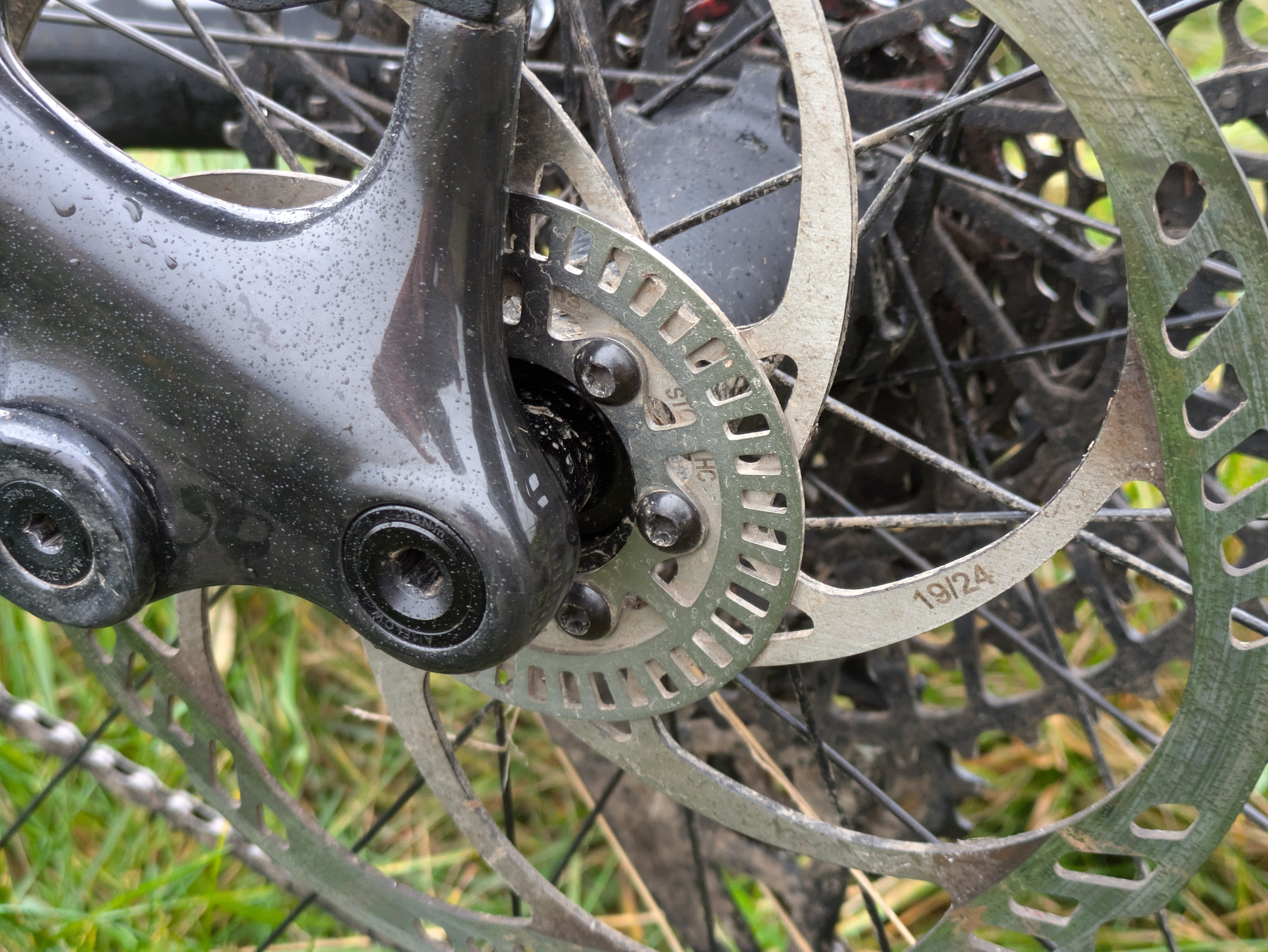 Amflow PL Carbon Pro overall bike shot
Amflow PL Carbon Pro overall bike shot
Overall
The Amflow PL Carbon Pro delivers an exhilarating and genuinely fun riding experience. The DJI Avinox motor lives up to the hype, and while the Boost mode’s peak power isn’t always trail-relevant, the motor’s unparalleled responsiveness and intuitive control are truly exceptional.
Any initial cynicism I had about the Amflow quickly dissipated within the first half-hour of riding. After a full day on the trails, I’m convinced that the DJI Avinox motor is currently the best e-bike motor available, offering a significant leap forward in performance. While the bike itself is a capable trail machine, refining the geometry, perhaps with adjustable geometry features, would elevate the Amflow PL Carbon Pro to an unbeatable level.
Amflow PL Carbon Pro Specification
- Frame // Carbon, 150mm
- Shock // Fox Float X Factory Evol, 185x55mm Trunnion
- Fork // FOX 36 Float Factory Grip X2, 160mm
- Wheels // Amflow HMC-30
- Front tyre // Maxxis Assegai, EXO+, 3C MaxxTerra 29×2.5in*
- Rear tyre // Maxxis Dissector, 3C MaxxTerra, 29×2.4in*
- Chainset // DJI Avinox SL Crank, 155mm, 34T
- Drivetrain // SRAM Eagle X0 AXS Transmission, 10-52T
- Brakes // Magura MT7 Pro, 203/203mm
- Stem // Amflow Enduro Stem One-piece CNC, 35mm, 35mm
- Bars // Amflow Enduro Carbon Handlebar 35, 800x25mm, 9° x 5°
- Grips // Amflow Enduro Lock-on
- Seatpost // Fox Transfer Factory, 155-180mm
- Saddle // Ergon SM Pro
- Bottom Bracket // DJI
- Motor // DJI Avinox M1, 105Nm (30 secs Boost at 120Nm)
- Battery // 800Wh tested
- Size tested // L
- Sizes available // M, L, XL, XXL
- Weight // 21.69kg (‘kerb weight’ as tested with *Continental Kryptotal Supersoft DH tyres, DMR Vault pedals and mudguard)
Geometry of our size L
- Head angle // 64.5°
- Effective seat angle // 77°
- Seat tube length // 450mm
- Head tube length // 115mm
- Effective top tube // 620mm
- BB height // 29mm BB drop
- Reach // 475mm
- Chainstay // 445mm
- Wheelbase // 1,255mm
Any questions?
Let us know your thoughts in the comments section below.
